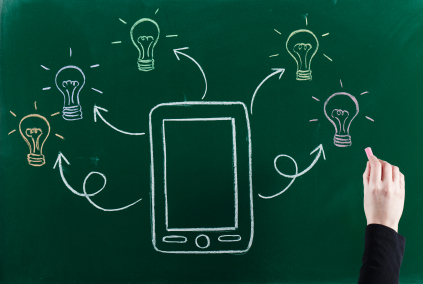 The UN recently reported that the number of people who own mobile phones outnumber the people who have access to flush toilets. We are highly dependent on our mobile devices - we rely on them to do everything, from communicate, browse the internet, play games, take pictures, etc. Mobile learning, then, has been a long time coming. We will use the example of Moodle, a learning management system (LMS) that fully supports mobile learning.
The UN recently reported that the number of people who own mobile phones outnumber the people who have access to flush toilets. We are highly dependent on our mobile devices - we rely on them to do everything, from communicate, browse the internet, play games, take pictures, etc. Mobile learning, then, has been a long time coming. We will use the example of Moodle, a learning management system (LMS) that fully supports mobile learning.
What is Mobile Learning?
Mobile learning is also referred to as “anytime-anywhere learning.” The “mobile” component is referring to two things - one, the mobile devices on which learning is conducted, and two, it stems from the term mobility, which is the ability to move around. Mobile learning is possible with Moodle because courseware lives online within the LMS, where it can be accessed from anywhere you have internet access.
Mobile learning has all the same benefits of e-Learning, with the added benefit of collaboration, fostering and facilitating communication, and increased mobility. Mobile learning with Moodle is configurable across a wide range of platforms. Smartphones, mobile phones, tablets, portable gaming devices, media players, and e-readers are all supported by Moodle, and can be used to deliver different components of mobile learning. The decision of which device to use in mobile learning depends on a number of variables, including where users are located (eg. at home, in transit, at school), how much time they have, and what work they are trying to do (eg. are they trying to read course material, or take a quiz?). As well, most learners switch between different devices when learning (i.e. they use multiple devices), so the ability to save work across platforms is an essential component of mobile learning that Moodle offers. Learning materials should be easily accessible, as well as easy to read, use, and engage, or else it isn’t likely that learners will use them.
What You Need to Know
One very important thing to keep in mind, is that the mobile aspect of e-Learning should not be primary, but complementary. It should not be used to deliver all course material and conduct all learning, but it should allow the welcome benefit of learning on the go. Understanding the strengths and weaknesses of each device is essential, as not all mobile devices have the same capabilities. The size of the mobile device also needs to be taken into consideration, as the size of the screen will affect what is possible on that particular device. Feature mobile phones should have limited use, as they are tiny, and do not have internet access. They can be used for texting, possible audio recording, and image capturing. Smartphones are a bit larger than feature mobile phones, and they have Internet access and various app capabilities, so they can be used significantly more. Tablets can be up to the same size as a laptop, and they have all the same capabilities but they offer more mobility. The only weakness with these is that typing can be a little more difficult.
How Is Mobile Learning Used?
In 2015, it was reported that 64% of Americans owned a smartphone (almost double what it was in 2011, at 35%). This means a majority of Americans are already mobile, which cuts down the adoption time. With that out of the way, using mobile learning methods is pretty simple. Mobile learning with Moodle can be used to deliver both static content, and multimedia content. Here are some examples of content that can be effectively delivered through mobile learning:
- Podcasts, audio lectures, and video lectures
- Gamification or game-based learning
- eBooks, or documents
- Delivering quick polls or quizzes in class
- Tests, assessments, and knowledge checks
What Are the Benefits?
Pen and paper tests can be daunting, and highly stressful. Mobile assessments can be done from anywhere, making the process more comfortable, and more efficient. Answers are recorded and stored online, for administrators to access and grade easily and quickly. As well, mobile assessments allow the opportunity to provide thorough feedback, not just checkmarks and x’s, allowing more space for users to learn, and grow. Users will be able to see whether their answer was correct, the total marks they received per answer, feedback, and what the correct answers were.
Every learner has different strengths and weaknesses, so mobile learning with Moodle also allows administrators to tailor the learning process to each individual learner, to ensure that they are getting all of their needs met. Communication is also enhanced, as it provides more methods to reach out. You can set up group discussions, forums, private and SMS messaging, real-time chat messaging, virtual classrooms, and video conferences.
If you want to learn more about Moodle's Advanced Features, check out our Complete Moodle User Guide - we go over all of the extended capabilities Moodle LMS has to offer.





